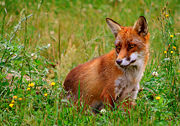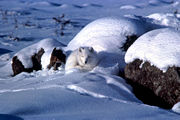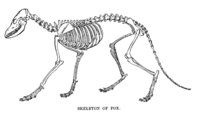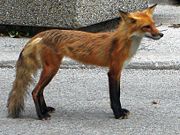Fox
2008/9 Schools Wikipedia Selection. Related subjects: Mammals
| Fox | ||||||||||||
|---|---|---|---|---|---|---|---|---|---|---|---|---|
 |
||||||||||||
| Scientific classification | ||||||||||||
|
Fox is a name applied to any of roughly 27 species of small to medium-sized canids, characterized by possessing a long, narrow snout, and a bushy tail, or "brush". By far the most common and widespread species of fox is the red fox (Vulpes vulpes), although various species are found on almost every continent. The presence of fox-like carnivores all over the globe has led to their appearance in the popular culture and folklore of many nations, tribes, and other cultural groups (see Foxes in culture).
Etymology
The Modern English "fox" is derived from Old English fox. The Old English word itself comes from the Proto-Germanic word *fukh – compare German Fuchs, Gothic fauho, Old Norse foa and Dutch vos. It corresponds to the Proto-Indo-European word *puke meaning "tail" (compare Sanskrit puccha, also "tail"). The bushy tail is also the source of the word for fox in Welsh: llwynog, from llwyn, "bush", Lithuanian: uodegis, from uodega, "tail", and Portuguese: raposa, from rabo, "tail".
General characteristics
Most foxes live 2 to 3 years, but they can survive for up to 10 years or even longer in captivity. Foxes are generally smaller than other members of the family Canidae such as wolves, jackals, and domestic dogs. Dogs (male foxes) weigh on average, 5.9kg and vixens (female foxes) weigh less, at 5.2kg (13 lbs and 11.5 lbs, respectively). Fox-like features typically include an acute muzzle (a "fox face") and bushy tail. Other physical characteristics vary according to their habitat. For example, the fennec fox (and other species of foxes adapted to life in the desert, such as the kit fox) has large ears and short fur, whereas the Arctic fox has small ears and thick, insulating fur.
Another example is the red fox which has a typical auburn pelt, the tail normally ending with white marking.
Unlike many canids, foxes are usually not pack animals. Typically, they are solitary, opportunistic feeders that hunt live prey (especially rodents). Using a pouncing technique practiced from an early age, they are usually able to kill their prey quickly. Foxes also gather a wide variety of other foods ranging from grasshoppers to fruit and berries.
Foxes are normally extremely wary of humans and are not kept as pets (with the exception of the fennec); however, the silver fox was successfully domesticated in Russia after a 45 year selective breeding program. This selective breeding also resulted in physical and behavioural traits appearing that are frequently seen in domestic cats, dogs, and other animals: pigmentation changes, floppy ears, and curly tails.
Classification
Canids commonly known as foxes include members of the following genera:
- Alopex -- Arctic fox, sometimes included with the "true" foxes in genus Vulpes.
- Cerdocyon -- Crab-eating fox
- Chrysocyon -- Maned wolf (in English), aguara guazú ("big fox" in Guarani) and zorro rojizo ("reddish fox", one of several names used by Spanish speakers).
- Dusicyon -- Falkland Island fox
- Lycalopex -- Hoary fox
- Otocyon -- Bat-eared fox
- Pseudalopex -- Four South American species, including the culpeo.
- Urocyon -- Gray fox, island fox and Cozumel fox
- Vulpes -- Including the ten or so species of true (" vulpine") foxes, including the red fox, V. vulpes, Tibetan fox, Vulpes ferrilata, and their closest kin.
Diet
The diet of foxes comprises rodents, insects, worms, fruit, fish, birds, eggs, and all other kinds of small animals. The fox generally consumes around 1 kg of food every day. Foxes that live in neighborhoods mainly depend on household waste and even rodents and birds that keep moving around these areas. Foxes are known to cache their food, burying the excess for later consumption.
They mostly thrive in the higher latitudes, suburban and even urban environments both in Europe and in North America. They are found also in Eurasia, North Africa, India ( Ladakh, Himalayas, Jammu and Kashmir, Rajasthan and Gujarat), China, Japan and in Australia.
Conservation
Foxes are readily found in cities and cultivated areas and (depending upon species) seem to adapt reasonably well to human presence.
Red foxes have been introduced into Australia and some other countries for hunting. Australia lacks similar carnivores, and the introduced foxes prey on native wildlife, some to the point of extinction. A similar introduction occurred in the seventeenth and eighteenth centuries in temperate North America, where European reds (Vulpes vulpes) were brought to the colonies for fox hunting, where they decimated the American red fox population through more aggressive hunting and breeding. Interbreeding with American reds, traits of the European red eventually pervaded the gene pool, leaving European and American foxes now virtually identical.
Other fox species do not adapt as well as the red fox, and are endangered in their native environments. Key among these are the crab-eating fox ( Cerdocyon thous) and the African bat-eared fox. Other foxes such as fennec foxes, are not endangered, but will be if humans encroach further into their habitat.
Foxes have been successfully employed to control pests on fruit farms, where they leave the fruit intact.
Historians believe foxes were imported into non-native environments long before the colonial era. The first example of the introduction of the fox into a new habitat by humans seems to be Neolithic Cyprus. Stone carvings representing foxes have been found in the early settlement of Göbekli Tepe in eastern Turkey.



